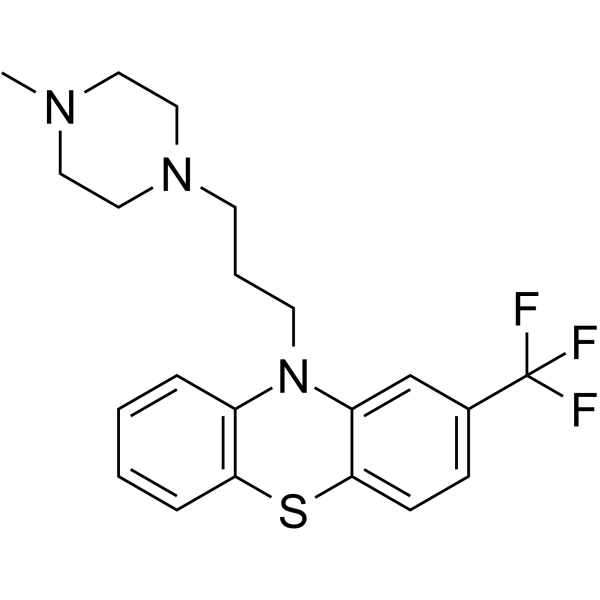Trifluoperazine |
| Catalog No.GC63240 |
Trifluoperazine (TFP) is an antagonist against dopamine receptors, act as antipsychotic agent and is widely used to treat schizophrenia or related psychoses .
Products are for research use only. Not for human use. We do not sell to patients.

Cas No.: 117-89-5
Sample solution is provided at 25 µL, 10mM.
Trifluoperazine (TFP) is an antagonist against dopamine receptors, act as antipsychotic agent and is widely used to treat schizophrenia or related psychoses [1,2]. Trifluoperazine is also a well-known calmodulin antagonist [3].
Trifluoperazine significantly restricted the invasion of glioblastoma cells at a concentration higher than 1 µmol/L, with a half-maximal effective concentration at around 10 µmol/L on invasion of U87MG cells by performing Matrigel transwell invasion assay. The ratio of proliferated glioblastoma cells was significantly decreased in TFP-treated cells [4]. Trifluoperazine inhibits cell vitality, proliferation, and induces cell apoptosis of HCT116 cells with IC50 =14 µM [3]. Trifluoperazine (30 µM, 24h) induced pancreatic adenocarcinoma (PDAC) MiaPaCa-2 cell death and decreased in intracellular availability of ATP [5].
Trifluoperazine (5 mg/kg/day) significantly suppressed the glioblastoma growth of the xenograft mice as evidenced by a marked decrease of glioblastoma tumor size in TFP-treated mice at day 21, there was no lung metastasis in TFP-treated group in the skin xenograft model [4]. Administration of TFP induced remarkably tumor regression with decreased tumor volume in the xenograft model of human HCT116 [3]. Trifluoperazine binds and mimics the effect of the genetic inhibition of NUPR1, a stress protein that promotes tumor growth and acts as a strong anticancer drug in vitro and in vivo in xenografted nude mice [6].
References:
[1]. de Oliveira Marques L, Soares B, de Lima M S. Trifluoperazine for schizophrenia[J]. Cochrane Database of Systematic Reviews, 2004 (1).
[2]. Hong M, Jenner P, Marsden C D. Comparison of the acute actions of amine-depleting drugs and dopamine receptor antagonists on dopamine function in the brain in rats[J]. Neuropharmacology, 1987, 26(2-3): 237-245.
[3]. Qian K, Sun L, Zhou G, et al. Trifluoperazine as an alternative strategy for the inhibition of tumor growth of colorectal cancer[J]. Journal of cellular biochemistry, 2019, 120(9): 15756-15765.
[4]. Kang S, Hong J, Lee J M, et al. Trifluoperazine, a well-known antipsychotic, inhibits glioblastoma invasion by binding to calmodulin and disinhibiting calcium release channel IP3R[J]. Molecular cancer therapeutics, 2017, 16(1): 217-227.
[5]. Huang C, Lan W, Fraunhoffer N, et al. Dissecting the anticancer mechanism of trifluoperazine on pancreatic ductal adenocarcinoma[J]. Cancers, 2019, 11(12): 1869.
[6]. Neira J L, Bintz J, Arruebo M, et al. Identification of a drug targeting an intrinsically disordered protein involved in pancreatic adenocarcinoma[J]. Scientific reports, 2017, 7(1): 1-15.
Average Rating: 5 (Based on Reviews and 30 reference(s) in Google Scholar.)
GLPBIO products are for RESEARCH USE ONLY. Please make sure your review or question is research based.
Required fields are marked with *




















